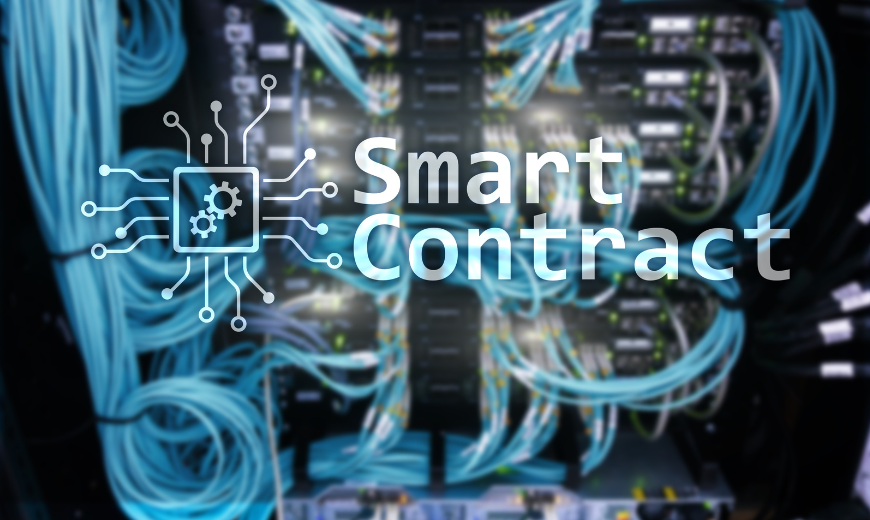
In the rapidly evolving world of blockchain technology, smart contracts have emerged as a revolutionary tool. But what exactly is a smart contract? If we’ve to explain it in simple words, ‘A smart contract is a self-executing contract with the terms of the agreement directly written into lines of code.’ These contracts automatically execute and enforce the terms of the agreement when predefined conditions are met. Ultimately, the smart contract deployment on any innovation eliminates the need for intermediaries and significantly enhances its security & efficiency. As a crypto enthusiast (if you’re well aware of the advantages of smart contracts), haven’t you ever thought about deploying your own smart contract on Ethereum?
Imagine you’re an artist wanting to sell digital artwork directly to buyers without the need for galleries or auction houses. Now, your blockchain enthusiast friend advised you to deploy a smart contract on Ethereum. By doing so, you can automate sales, ensure you receive royalties every time your art is resold, and maintain a transparent, tamper-proof record of transactions. This way, not only can you maximize your profits but also ensure your creative work is protected and fairly compensated.
Isn’t this cool? Thus, we can clearly say, ‘The significance of creating smart contracts on Ethereum cannot be overstated’. On one side, we’ve Ethereum – a robust and versatile blockchain ecosystem renowned for providing a secure, transparent, and decentralized environment. On the other hand, there is a smart contract – an innovative self-contract technology. By leveraging smart contracts on Ethereum, your businesses will be able to operate more efficiently, reduce costs, and increase trust among parties.
After reading up here, you must be thinking that smart contract deployment on Ethereum sounds incredibly beneficial, but how should you actually do it? Well, that’s where we come in. In this detailed blog post, we’ll thoroughly look at the process, explaining how, in the modern era of 2024, you can easily create a smart contract on Ethereum in 10 simple steps. Before discussing the steps, let’s unravel how, exactly, Ethereum runs smart contracts and what type of execution it demands.
How does Ethereum Runs Smart Contracts?
Ethereum blockchain uses EVM (Ethereum Virtual Machine) to run smart contracts smoothly on its platform.
“EVM (Ethereum Virtual Machine) is a software program designed to manage transactions, smart contracts & updates.”
Since EVM has a stack-based architecture and a 256-bit word size, it uses fundamental cryptographic techniques (Native hashing and elliptic curve) to make a transaction to its rightful owners.
Every time something happens on the Ethereum network, like a transaction or an update to a smart contract, the EVM takes the current state (like the present state of an account or a contract), processes the new information (like a transaction), and updates the state accordingly. Therefore, it smoothly moves the system from one ‘block’ to the next, ensuring a safe transaction.
Different Languages for Deploying Smart Contracts on Ethereum
The process of smart contract deployment on Ethereum is incomplete without the use of a programming language. There are various smart contract languages that allow the hassle-free deployment of smart contracts on Ethereum. Some of the most popular ones are given below:
1. Solidity
This statically typed and object-oriented programming language is the most preferred when it comes to smart contract deployment on Ethereum. Solidity was first launched in 2014, and various Ethereum core contributors, including Christian Reitwiessner and Alex Beregazaszi, were credited as its developers. Solidity writes its codes using JavaScript, C++, and Python.
2. Vyper
Vyper is a statically typed, contract-oriented Pythonic programming language used to deploy smart contracts on Ethereum. It first appeared in the industry in 2017. Many professional developers regarded Vyper as the easiest programming language for smart contract deployment because it uses Python.
3. Rust
Rust is often not regarded as an ideal programming language for deploying smart contracts on Ethereum. However, it is a preferred choice for non-EVM blockchains like Solana, Polkadot, and more. The use of programming languages in smart contract deployment also serves as a major point in the Ethereum vs Solana debate.
Steps for Smart Contract Deployment on Ethereum
After reading up here, you would have surely understood about the smart contract and its significance of deploying on Ethereum. Now, let’s discuss a topic most of you would have clicked on in this blog post: Steps for Smart Contract Deployment on Ethereum.
Since Solidity is the most preferred programming language for smart contract development, we’ve mentioned the process of deploying smart contracts on Ethereum using Solidity only.
Step #1: Creating a New Ethereum Project in Infura ID
Start by creating a new Ethereum project using the Infura project ID. Then, change the end point from Mainnet to rinkby network.
(The rinkby network allows us to deploy contracts without spending real Ethereum)
Then, you’ll similar find code like this
| nkdir deploy_contract cd deploy_contract npm init – y |
Step #2: Set Up Your Development Environment
First and foremost, you’ll need to set up your development environment. So, if you don’t have Node.js and npm installed, consider installing them first with the following first two commands,
According to industry professionals, Truffle is an ideal testing framework for Ethereum smart contracts.
So, choose Truffle for smart contract deployment. Install it using the following command (given at the bottom) to download it.
| # Install Node.js and npm (if not already installed) sudo apt update sudo apt install nodejs npm # Install Truffle globally npm install -g truffle |
Step #3: Create a New Truffle Project
Next, initialize a new Truffle project to manage your smart contracts.
| # Create a new directory for your project mkdir MySmartContract cd MySmartContract # Initialize a new Truffle project truffle init |
Step #4: Write Your Smart Contract in Solidity
Open the `contracts` directory, create a Solidity File (`MyContract.sol`), and write your smart contract code.
| // contracts/MyContract.sol pragma solidity ^0.8.0; contract MyContract { uint256 public value; function setValue(uint256 _value) public { value = _value; } } |
Step #5: Compile Your Smart Contract
Use Truffle to compile your smart contract.
| # Compile the contract truffle compile |
Step #6: Configure the Deployment Script
Here comes the important step: Update the `migrations` file to deploy your contract.
| // migrations/2_deploy_contracts.js const MyContract = artifacts.require(“MyContract”); module.exports = function (deployer) { deployer.deploy(MyContract); }; |
Step #7: Set Up a Local Ethereum Network
Though this is an optional step, you should still consider it. Use Ganache to set up a local Ethereum blockchain for testing.
| # Install Ganache CLI globally npm install -g ganache-cli # Start Ganache ganache-cli |
Step #8: Deploy Your Smart Contract
Proceed to deploy the contract to the Ethereum (Use local network for testing).
| # Migrate the contract (deploy it to the specified network) truffle migrate –network development |
Step #9: Interact with Your Deployed Smart Contract
Use Truffle Console to interact with your deployed contract.
| # Open Truffle Console truffle console –network development # Interact with the contract let instance = await MyContract.deployed() instance.setValue(42) let value = await instance.value() console.log(value.toString()) // Should print ’42’ |
Step #10: Deploy to a Public Test Network (Rinkeby, Ropsten, Etc.)
Deploy your contract to a public Ethereum test network.
First, set up your `truffle-config.js` to include a public network configuration. You’ll need an Infura project ID and HDWalletProvider, the best digital wallet.
| // truffle-config.js const HDWalletProvider = require(‘@truffle/hdwallet-provider’); const infuraKey = “your_infura_project_id”; const mnemonic = “your_metamask_seed_phrase”; module.exports = { networks: { rinkeby: { provider: () => new HDWalletProvider(mnemonic, `https://rinkeby.infura.io/v3/${infuraKey}`), network_id: 4, // Rinkeby’s network id gas: 4500000, // Gas limit gasPrice: 10000000000 // 10 gwei } }, compilers: { solc: { version: “0.8.0” } } |
At last, deploy your contract to the rinkby test network. Since we’ve already done it in the first step, you can also ignore this.
Note:
Consider deploying demo smart contracts on Ethereum so that you can get an idea of how to do it correctly. There may be terms such as gas price and Ganache, which many of you might even know. However, while working on smart contract deployment, you’ll get to know about them. So, don’t worry much.
Takeaway
Smart contracts are one of the best blockchain innovations of the last decade, revolutionizing how agreements and transactions are executed. These self-executing contracts, which are embedded with code that automatically enforces the terms of the agreement, offer numerous benefits. Most importantly, they eliminate the need for so-called reliable intermediaries, eventually reducing costs and increasing productivity & efficiency. That’s why deploying smart contracts on Ethereum brings various advantages for crypto users. This smart contract deployment on Ethereum opens up new possibilities for DeFi, supply chain management, and other sectors.
Frequently Asked Questions (FAQs)
Q-1. What is smart contract deployment?
Ans: Smart contracts are self-executing contracts that enable the smooth fulfilment of terms of the agreement by writing them into code. Thus, the process of uploading a smart contract onto a blockchain network like Ethereum or Bitcoin is known as smart contract deployment.
Q-2. What is the best programming language for smart contract deployment on Ethereum?
Ans: Solidity is by far the most preferred programming language for deploying smart contracts on Ethereum. It first appeared in 2014, and this object-oriented language writes code using JavaScript and C++.
Q-3. In which network should the endpoint on the Infura project ID be changed?
Ans: When creating a new Ethereum project in Infura project ID, consider changing the end point from Mainnet to Rink by the network.






